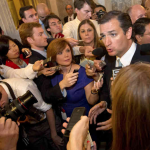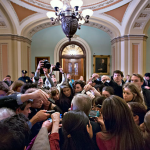Current members are living at a time with only a 24 hour news cycle, Facebook posts and a constant stream of information (and misinformation) posted to Twitter. As of yet, cameras are not clipped to every lapel of nearly every member of the House and Senate. And as far as I know not a single member has taken to wearing Google Glass throughout his or her day.
Of course, cameras on every lapel would provide quite the fodder for every cable channel, Web outlet and anybody who wanted to watch Congress do its work. But to see how digestible that is watch C-SPAN, or any of the meetings C-SPAN webcasts or that the committees or agencies webcast themselves. And this is just U.S. federal government, not states and municipalities and it is far from the global initiative in The Circle.
The cameras would provide a glimpse at who the elected officials are meeting with when the official cameras are not rolling, but the bigger question is, would the information be useful?
With that many feeds there is no way even the entirety of Internet users could consume, digest, and make sense of it all. When this many people try, some users will find a nugget of information but many others will latch on to a morsel he or she does not understand and blow it out or proportion, no different from how things happen online and then move to television without wearable cameras.
If the goal of getting all lawmakers to be “transparent” is to provide unfiltered information to every citizen then remember that all information is filtered. Those filters serve to process the information. C-SPAN provides full coverage of Congress but how many people really watch it? Some professional journalists watch, many watch for the parts needed but how many people watch truly uninterrupted gavel-to-gavel coverage of every minute of every activity that happens in the House and Senate. In part because it is not possible. For practical reasons some filters are needed.
Filters are needed to:
- Provide expertise; legislative topics are complex and oftentimes not limited to a single topic.
- Offer context; not everybody can sit and watch the feeds all day, even people who can watch feeds cannot watch all of them all the time, somebody is needed to say where everything fits
- Discard the garbage; Most of what is recorded now is not newsworthy or even interesting. Add more raw information and there will be more to discard. We see this same trend for information in general, the more information the more noise.
“Transparent” government would not mean the end of a political press, it would mean a somewhat different job for the political media and a different way of doing their current job. Reporters who now fill the Capitol’s hallways will still need to do that. Reporters will watch some feeds but will still need to make phone calls to make sense of the information, or to know where lawmakers are going to be and when. Unless every meeting ends with a clear “I support X” someone is still going to be needed to figure out where elected officials stand on every issue.
More importantly, no matter how good the cameras are, reporters would still swarm around Eggars’s fictional congresswoman and it is unlikely in that situation that a camera worn on a lapel or around someones neck would be able to capture very much usable picture or audio as you can see in the two pictures below. These are two real “scrums” around two real Senators outside the Senate chamber. I have been in these mass gatherings of journalists and it is hard to get any useful nugget from a camera and microphone pointed directly at the subject. Wearables on officials will capture next to nothing of value.
- Reporters surround Sen. Ted Cruz in the Capitol. | NPR
- Reporters surround Sen. Dick Durben in the Capitol. | U.S. News & World Report

